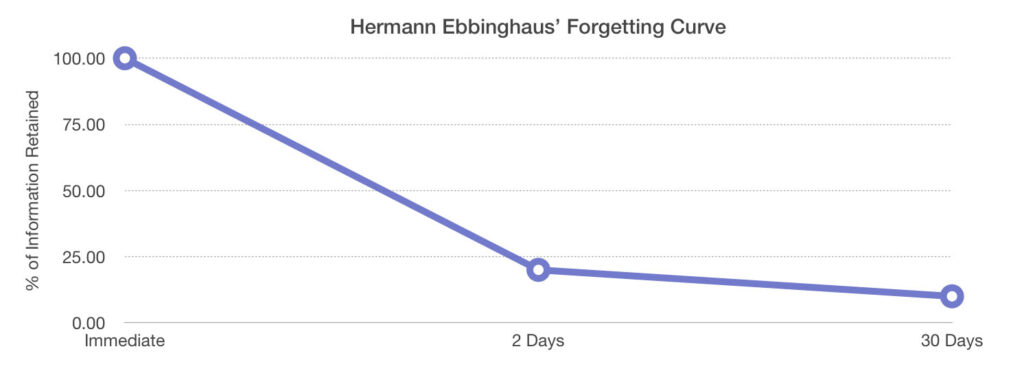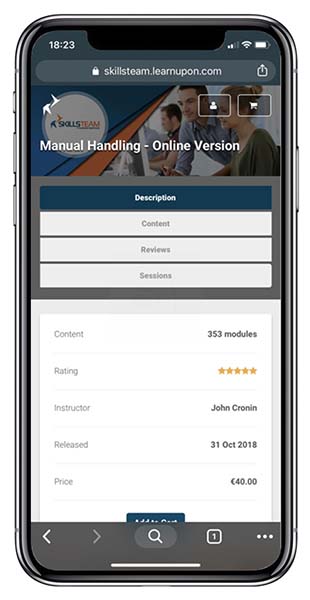5 EASY TIPS TO REINFORCE TRAINING
You decided to invest in training and had high hopes it would benefit your staff and your organisation.
So, why on earth is there no evidence of any change in your employees’ work?
Surely they can’t have forgotten the new information already!
It is, unfortunately, possible that they have…
Forgetting is not a new phenomenon:
Herman Ebbinghaus’ Forgetting Curve already demonstrated back in the 19th century that the human brain is wired to forget information unless it is reinforced and repeated at regular intervals.

This research has been updated over the years and continues to confirm that without any context or recall, 80% of new knowledge is forgotten within two days and 90% within 30 days.
That’s a shocking statistic, particularly if you are investing in training for your staff.
Retention requires the information to stick so it can be recalled and applied when needed, and that is where training reinforcement comes in.
Training reinforcement is rooted in learning science, which finds that information presented at spaced intervals is retained better.
So here are a few things you can do stop that valuable new knowledge from fading away:
ON-THE-JOB REINFORCEMENT:
We learn by doing, so this is where skills learned in training can be put into practice immediately after a course.
No more theoretical training scenarios: employees must be confronted with situations that have a real impact on the organisation and in which they have no option but to recall new skills to deal with them.
It is critical that the organisation fosters a culture of learning so that these events become learning moments.
If your staff feels comfortable testing out new knowledge without fear of repercussion, it is more likely to stick.
MENTORING:
Support, advice, and guidance for the trainees in the weeks and months after the training can make a big difference to retention.

Organisations that are serious about training appoint a mentor, someone who understands the content of the training courses and how they impact on the business, so the mentor is often a line manager or someone from Learning and Development. Micro-
LEARNING:
This is an increasingly popular trend. A study by the University of California has shown that people get interrupted in work on average every 15 minutes, which makes it impossible to dedicate any significant amount of time to training.

This is where micro-learning comes in: it involves small chunks of focused learning content that take up very small amounts of time – for instance, a 3-5 minute video or a 10-20 minute specific online training course.CHECK OUT OUR E-LEARNING COURSES HERE
These can be incorporated into the working day and are a great way to keep people thinking about a particular topic.
LEVERAGE TECHNOLOGY:
MOBILE PHONES
Start off small and simple with mobile phones.
Research by CareerBuilder has shown that 70 percent of employees keep their phones “within eye contact”, so take advantage of that.

Send them interesting content via text or email or apps that they can access quickly and easily.
The more user-friendly and mobile-friendly it is, the more likely employees are to engage with it.
GAMES AND GAMIFICATION
Games and gamification are proving very effective and are being increasingly used to encourage knowledge retention.

Gamification is proving very effective for knowledge retention.
Theknowledgeguru.com released a 2018 Learning Trends Report that revealed more and more learning and development professionals are including games and gamification in their training.
Game-based learning can be through mobile, Virtual Reality and Augmented Reality, eLearning, and even instructor-led training, live and online.
HIGH TECH
High tech is where we are heading!
According to research conducted in 2018:
- 15% of enterprises are currently using Artificial Intelligence (AI), BUT 31% are expected to add it over the coming 12 months (Adobe)
- 61% of business professionals point to machine learning and AI as their company’s most significant data initiative for 2019 (MemSQL)
AI devices are already available and are increasingly going to be used for training.

Chatbots, voice recognition and even virtual coaches are already on hand to answer staff questions.
In fact, some chatbots have been passing the Turing test (a test of computer intelligence requiring that a human is unable to tell if he or she is talking to a machine or another human).
Conversational AI is opening up a host of new possibilities for training reinforcement. Giants like Google, Intel, Apple, and Microsoft are already using AI and developing it further.
FORMAL REINFORCEMENT PROGRAMMES
Formal reinforcement programmes simply amalgamate all the above into a structured approach that incorporates learning touchpoints, feedback loops, and other elements that reinforce the learning process.
It needs to be kept simple, fun and engaging, using tools such as micro videos, articles, podcasts, some little checks or tests (in the shape of quizzes/games) or anything that can help knowledge stick.
Let’s face it, your ROI on training plummets if new knowledge from training courses is not retained effectively.
In a world where attention spans are decreasing, information retention is fading fast and the pressures on people’s working lives are increasing, training reinforcement is essential.
While our five tips above may not help you remember where you left your keys, they will make forgetting what was learned in training a thing of the past.

